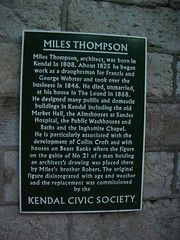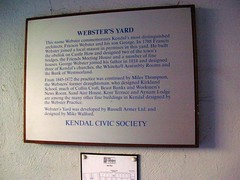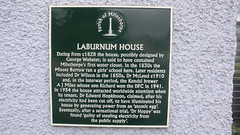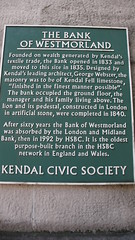George Webster
Commemorated on 8 plaques
Milnthorpe Parish Church. St Thomas Church was built in 1837 as a Chapel of Ease to St Peter's Heversham to which Church Street leads. It was designed by George Webster to hold '600 hearers' and named as a tribute to Mrs Thomasin Richardson who gave £1000 towards the building costs of £2,200. The first Vicar Nicholas Padwick stopped the Sunday Hiring of farm labourers as their drunken revelry on The Green disturbed the congregation. The Chancel and north porch were added in 1883 and the Church Centre with an upper hall replaced the gallery area in 1982. Milnthorpe became a separate ecclesiastical Parish in 1924 but was reunited with Heversham in 1993.
The Square, Milnthorpe, United Kingdom where they designed (1836)
The KENDAL LANCASTER CANAL. This canal, completed in 1819, brought coal into Kendal from Lancashire and carried out limestone and manufactured goods. By providing cheap coal to replace water power with steam power it enabled Kendal's manufacturing industry to expand, the Kendal yards then developing as workshops and workers' housing. The canal terminated at Canal Head with warehouses, wharves and stables, the whole complex being designed by the Kendal architect George Webster. This plaque is mounted on the former canal ticket office. The opening of the Kendal railway in 1847 led to a decline in canal traffic and in 1856 the warehouses became an engineering works. The canal was filled in in 1947.
Canal Head, Kendal, United Kingdom where they designed (1818)
Miles Thompson. Miles Thompson, architect, was born in Kendal in 1808. About 1825 he began work as a draughtsman for Francis and George Webster and took over the business in 1846. He died, unmarried, at his house in The Lound in 1868. He designed many public and domestic buildings in Kendal including the old Market Hall, the Almshouses at Sandes Hospital, the Public Washhouses and Baths and the Inghamite Chapel. He is particularly associated with the development of Collin Croft and with the houses on Beast Banks where the figure on the gable of No 21 of a man holding an architect's drawing was placed there by Miles's brother Robert. The original figure disintegrated with age and weather and the replacement was commissioned by the Kendal Civic Society.
Beast Banks, Kendal, United Kingdom where they mentioned (1824)
WEBSTER'S YARD. This name Webster commemorates Kendal's most distinguished architects. Francis Webster and his son George. In 1788 Francis Webster joined a local mason in premises in this yard. He built the obelisk on Castle How and designed two of the town's bridges, the Friends Meeting House and a number of fine houses. George Webster joined his father in 1818 and designed three of Kendal's churches, the Whitehall Assembly Rooms and the Bank of Westmorland. From 1845 - 1872 the practice was continued by Miles Thompson, the Websters' former draughtsman, who designed Kirkland School, much of Collin Croft, Beast Banks and Workmen's News Room. Sand Aire House, Kent Terrace and Aynam Lodge are among the many other fine buildings in Kendal designed by the Webster Practice. Webster's Yard was developed by Russell Armer Ltd. and designed by Mike Walford.
94 Highgate, Kendal, United Kingdom where they is commemorated (1817-1844)
THE NATIONAL SCHOOL. The School was designed by George Webster and was built and run by public subscription. It opened to boys in 1819 for their "education in Religious Knowledge and useful learning". It was the first public day school in Kendal, incorporated with the National Society for promoting "the education of the poor in the principles of the Established Church". Matthew Pyper of Whitehaven endowed the school with £2000. He died in 1821 and, at his wish, was interred in a vault near the centre of the school building. A Girl's School opened in 1824 for instruction in reading, writing and the common rules of arithmetic, singing, knitting and sewing. An Infant's School was opened in 1874. The Schools evolved, merged and eventually became the Central School. From 1874 the buildings were used as an annexe to Vicarage Park School. In 1985 they were closed and a housing complex was built on the site. An original memorial plaque still exists there.
Beast Banks, Kendal, United Kingdom where they designed (1818)
LABURNUM HOUSE. Dating from c1828 the house, possibly designed by George Webster, is said to have contained Milnthorpe's first water closet. In the 1830s the Misses Burrow ran a girls' school here. Later residents included Dr Wilson in the 1850s, Dr McLeod c1910 and, in the interwar period, the Kendal brewer A J Miles whose son Richard won the DFC in 1941. In 1954 the house attracted worldwide attention when its tenant, Dr Edward Hopkinson, claimed, after his electricity had been cut off, to have illuminated his house by generating power from an 'atomic egg'. Eventually, after a sensational trial, 'Dr Hoppy' was found 'guilty of stealing electricity from the public supply'.
Main Street, Milnthorpe, United Kingdom where they designed (1827)
THE BANK OF WESTMORLAND. Founded on wealth generated by Kendal's textile trade the bank opened in 1833 and moved to this site in 1835. Designed by Kendal's leading architect, George Webster, the masonry was to be of Kendal Fell limestone, "finished in the finest manner possible". The bank occupied the ground floor, the manager and his family living above. The lion and its pedestal, constructed in London in artificial stone, were completed in 1840. After sixty years the Bank of Westmorland was absorbed by the London and Midland Bank, then in 1992 by HSBC. It is the oldest purpose-built branch in the HSBC network in England and Wales.
64 Highgate, Kendal, United Kingdom where they designed (1834)
Oddfellows Hall. This hall has a long and varied history. The Unicorn Inn originally stood on the site. It was replaced in 1833 by Kendal architect George Webster for the local lodge of the Oddfellows, a Friendly Society for working men, which provided social and educational activities, including the occasional public play. For a time the ground floor was let off as a beer-house, the Nelson Tavern. The Mechanics' Institute took over the hall in 1857. For a short time in 1890-1 it became The People's Palace to provide wholesome entertainment and instruction for the labouring classes. During both World Wards and later, the hall was used by local clubs. Before conversion to housing it had been the Kingdom Hall of the Jehovah's Witnesses.
Highgate, Kendal, United Kingdom where they designed








